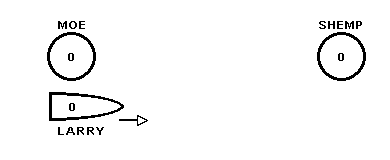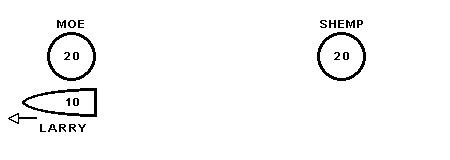
8. The Twin Paradox
The Twin Paradox [Also called the "Clock Paradox"] is one of the classic "paradoxes" of Special Relativity. There have been a pavillion papers written on the subject and various forms of it surface as "refutations" of SR now and then.
Basically the Twin Paradox is this:
Larry and Moe are twins. On his (and Moe's) 20th birthday Larry climbs in a rocket and zips off at 86.6% the speed of light. He does this for a while then he turns around and zips back to earth at the same speed. When he gets back he catches up with his twin brother Moe again and, lo and behold, Moe is 40 while Larry is only 30 (!).
The point is that Larry has been moving at such a speed that his "clocks" run half the speed of Moe's clocks due to relativistic time dilation. Therefore only half as much time has elapsed in Larry's spaceship as has elapsed back on earth with Moe. On earth 20 years have gone by but in Larry's spaceship only 10 years have gone by. Larry is younger than his twin brother Moe!
Let's see it in pictures. We'll add a planet far from earth and
at
rest with respect to the earth on which Moe's brother Shemp lives.
 |
|
|
 |
|
|
 |
|
|
 |
|
|
BUT WAIT!
BUT WAIT (1): "But wait! Couldn't Larry consider himself at rest and Moe (as well as the earth) as moving? In that case Moe's clocks would run slower due to relativistic time dilation and Moe would be younger than Larry."
This attempt at applying symmetry to the situation fails due to the fact that Larry turned around in the middle of his journey. He "sloshed coffee on his shirt." Moe and Shemp, on the other hand can consider themselves in an inertial frame for the whole time. Thus the fundamental asymmetry of the situation keeps this argument from working. Since only one twin has coffee stains on his shirt HE is the one that flew away and then returned; he is the one that experienced inertial effects of changing frames.
BUT WAIT (2): "But wait! During the time that Larry was traveling away he was in an inertial frame and could consider himself at rest. During that time he could consider himself at rest and Moe and Shemp as moving. Then for that part of his journey Moe's and Shemp's clocks would be running slower than his (as measured in Larry's frame). Also on the return part of the trip he would again be in an inertial frame and could consider himself at rest (albeit with coffee stains on his shirt) and then Moe would be moving toward him. In that case Larry could again consider Moe's and Shemp's clocks as running slower than his own. Thus during BOTH phases of Larry's trip Moe's and Shemp's clocks are running slower than Larry's clock (as measured by Larry) But in Moe's and Shemp's frame Larry's clock has been running slower for the whole trip. So, special relativity must be inconsistent; it gives contradictory calculations."
The "fly in the ointment" of this argument is, as usual, ignoring the relative property of simultaneity. While it is true that during each phase of Larry's trip Moe's and Shemp's clocks are running slower than Larry's (when measured in Larry's frame) a simultaneity trick gives Moe's clock more elapsed time at the end.
To see this let's forget about the turnaround and the sloshing coffee
and bring in another observer -- Curly. In this version there will be no
acceleration at all. Moe sits on the earth. Larry comes flying by in his
spaceship and looks at Moe's clock as he passes. It just turns out that
at that instant Moe has set his clock to zero. Thus as Larry flies by his
and Moe's clocks read zero. But Shemp's clock is synchronized with
Moe's in Moe's and Shemp's inertial frame. Therefore by Rule
1 they are not synchronized in Larry's frame. In fact Shemp's
clock (the rearward of the two) is ahead of Moe's by, in this case, 7.5
years.
 |
|
|
Now Larry flies on for a few years. Then he encounters Curly flying
in his spaceship TOWARD the earth. Curly and Larry pass each other
by Shemp's planet. Curly looks in Larry's window as he flies by and
sets his clock to match the reading on Larry's clock. In Larry's
frame he is not flying anywhere, of course. In his frame Moe and
Shemp are flying by him as he just sits there in his spaceship floating
motionless in space.
 |
|
|
However in Curly's frame Moe and Shemp are traveling in the opposite
direction as in Larry's frame. This means that in Curly's frame Moe's
planet (earth) is the rearward one and therefore (when measured in Curly's
frame) Moe's clock is 7.5 years ahead of Shemp's
 |
|
|
He flies on until he comes to earth and Curly and Moe compare clocks
through their windows as Curly passes by. (or as Moe passes by if we want
to look at from Curly's viewpoint.) Curly (and Moe) notice that Curly's
clock reads 10 years while Moe's reads 20 years.
 |
|
|
In the first part of the trip Larry's clock recorded 5 years elapsed time while Larry noticed that Moe's and Shemp's clocks recorded 2.5 years elapsed time. In Larry's frame the other clocks were running slower than his. It was the fact that (in Larry's frame) Shemp's clock was 7.5 years ahead of Moe's that accounted for Shemp's clock reading 10 years when Larry's clock read 5 years.
As Larry leaves Moe in his wake he is aware of Moe's clock running slower than his. But that means that he knows what Moe's clock reads at any given instant. But that means simultaneity of distant events. The claim that MY clock reads 2 years while Moe's only reads 1 year involves, in its very utterance that the measurements are made simultaneously. But events which are simultaneous in one frame are not simultaneous in another. In Moe's frame the two events (1) Larry's clock says 2 years and (2) Moe's clock says one year did not occur at the same time. In fact in Moe's frame Larry's clock said 2 years long after Moe's clock said 1 year. In Moe's frame Moe's clock said 4 years at the same time that Larry's clock said 2 years. [remember: if the events are simultaneous in "their own" frame then in a frame in which they are moving the rear event happens before the front event.] In Moe's frame the rear event (Moe's clock says 1 year) happened long before the front event (Larry's clock says 2 years).
When Curly flies by and sets his clock by Larry's The situation in Larry's frame is:
1) Larry's (and Curly's) clock reads 5 years.However in Curly's frame These are not simultaneous. In Curly's frame the situation is:
2) At the same time Moe's clock reads 2.5 years.
1) Curly's (and Larry's) clock reads 5 years.But he measures Moe's clock as running at half the speed as his clock so Moe's clock has added only 2.5 years since Curly set his clock. Thus Moe's clock will read 20 years -- 2.5 years more than the 17.5 that it read when Curly set his clock to 5 by looking in Larry's window.
2) At the same time Moe's clock reads 17.5 years.
In Moe's frame the Larry-Curly flyby was simultaneous with Moe's (and Shemp's) clock reading 10. Then Curly's clock, running slow, added only 5 years during the 10 years it took to reach earth. No matter how you cut it, Curly's clock reads 10 when he reaches earth while Moe's clock reads 20.
When the "information" changed inertial frames by a peek in Larry's
window the whole picture
changed in terms of "now." In Larry's frame the earth clock read 2.5
"now." In Curly's frame the earth clock read 17.5 "now." In Moe's frame
his (the earth) clock read 10. If we eliminate Curly and just have
Larry turn around then as far as clock readings go everything works out
the same. (We are ignoring the time it would take Larry to turn around
at such speeds.)
The elapsed time along the Larry to Curly to Moe route was less than along just the Moe route.
Simultaneity -- Don't take it for granted.
Next: 9. More on the Twin Paradox
Send all comments, criticisms and reactions to